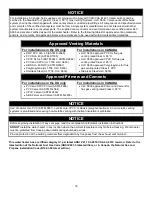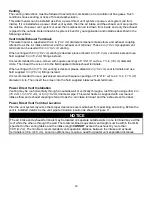
7
Temperature and Pressure Relief Valve
WARNING
Keep clear of the combination temperature and pressure relief valve discharge line outlet.
The discharge may
be hot enough to cause scald injury. The water is under pressure and may splash.
For protection against excessive temperatures and pressure, install temperature and pressure protective
equipment required by local codes;
not
less than a combination temperature and pressure relief valve certified by
a nationally recognized testing laboratory that maintains periodic inspection of production of listed equipment or
materials as meeting the requirements of the Standard for
Relief Valves and Automatic Gas Shutoff Devices for
Hot Water Supply Systems, ANSI Z21.22
and the Standard
CAN1-4.4 Temperature, Pressure, Temperature and
Pressure Relief Valves and Vacuum Relief Valves
. The combination temperature and pressure relief valve must
be marked with a maximum set pressure that does
NOT
exceed the maximum working pressure of the water
heater. The combination temperature and pressure relief valve rating must
NOT
be less than the hourly rating of
the water heater.
Install the combination temperature and pressure relief valve into the opening provided and marked for this
purpose on the water heater.
Note:
Some models may already be equipped or supplied with an installed combination temperature and
pressure relief valve. Verify that the combination temperature and pressure relief valve is in compliance with local
codes. If the combination temperature and pressure relief valve does not comply with local codes, replace it with
one that does. Follow the installation instructions on page 11.
Install a discharge line so that water discharged from the combination temperature and pressure relief valve will
exit within 6 in
(15.2 cm)
above, or any distance below the structural floor and
cannot
contact any live electrical
part. The discharge line is to be installed to allow for complete drainage of both the combination temperature and
pressure relief valve and the discharge line where it will
NOT
damage property. The discharge opening must
NOT
be subjected to blockage or freezing.
DO
NOT
thread, plug or cap the discharge line. It is recommended that a
minimum clearance of 4 in
(10.2 cm)
be provided on the side of the water heater for servicing and maintenance of
the combination temperature and pressure relief valve.
DO NOT place a valve between the combination temperature and pressure relief valve and the tank.
Condensate Drain
The water heater should either be raised several inches above the floor on a concrete slab or use a low-profile
condensate pump to allow free drainage of condensate from the elbow drain fitting. This water heater is a
condensing type unit and requires a drain to be located in close proximity to allow the condensate to drain
safely. The condensate drains from the unit at the field installed exhaust condensate elbow located near the
bottom of the unit. Using
1” PVC create a drain trap, as shown in Figure 2, which connects to the condensate
elbow using the supplied rubber coupler.
Also use 1” PVC from the drain trap to the drain. Make sure the condensate drains line slopes down, away
from the water heater at least 1/8 in per foot toward the drain. The condensate drain pipe must
NOT
be routed
through an area subject to below freezing temperatures. The condensate build-up will block the exhaust outlet,
which will cause improper operation. Refer to Figure 2 for the proper connection of an elbow to the drain outlet
and a condensate trap.
CAUTION
Failure to properly install the condensate drain as directed above, as well as shown in Figure 2, may result in
damage and/or cause improper operation of to the water heater. Any damage resulting from failure to install
the condensate drain as directed will
NOT
be covered by the warranty.
Summary of Contents for LUHE120T
Page 42: ...42 BMS Wiring Diagram...
Page 44: ...44 Lighting and Shutdown Instructions Figure 31 Lighting Instruction Label...
Page 62: ......
Page 63: ......






















